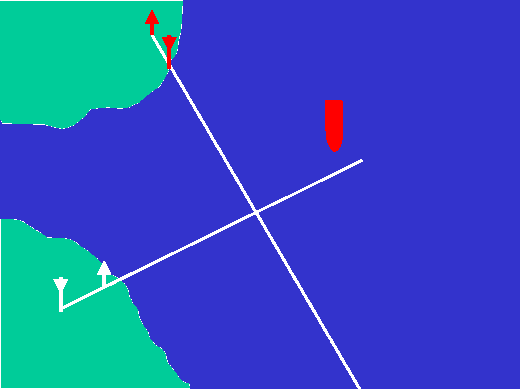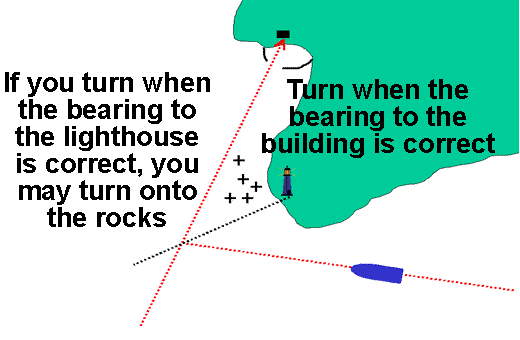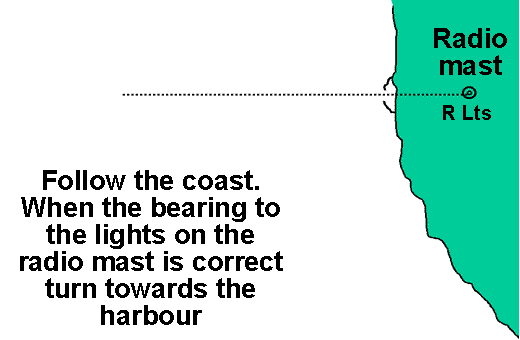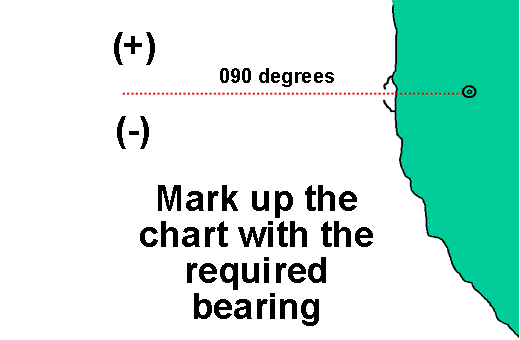Transits are one of the most valuable tools when close to dangers or the land. The main benefits of transits are:
- There is no compass deviation or variation.
- They can be used when the vessel's motion interferes with the use of a compass.
- They are instantaneous and can be monitored continuously.
- They occur frequently when in confined waters.
Many areas with tricky pilotage problems will have a series of transits ready set up to assist mariners. However, there are several other uses for transits.
Single transits
Frequently a proper fix is not really necessary. All that may be required is a single position line, then a few minutes later, another at a good angle of cut to the first.

The first transit gives a good idea of the distance run, then the second, taken a few minutes later and combined with the knowledge of the course steered, gives an accurate measure of the distance off the shore.
This type of situation occurs every few minutes when close to the land. The objects used for the transits do not need to be navigational marks; there are normally plenty of buildings, headlands or other distinct features.
An experienced navigator can estimate the vessel's position fairly accurately using this approach, giving them the benefit of spending more time on deck to monitor the overall situation.
Transits to check ground track
Because the currents close in to the shore vary in speed and direction, one of the best checks of track over the ground is to create a transit with the destination mark and an object in the background. If the vessel is heading directly towards the mark, it will appear fixed against the background. However, if the mark is moving relative to the background, the vessel is being carried to the side of the mark that the destination appears to be moving.
Other uses for single bearings and transits
There are some other uses for single bearings or transits that can allow quick decisions to be made simply.
Turning on a single bearing
When it is necessary to make a major turn at a headland or around a hazard, the point to turn can be indicated by the use of a single bearing or transit. However, there are some important points that may not be obvious.
The principle is that the bearing that is used to indicate the point of the turn, should be taken on an object that will be as close as possible to directly ahead, or astern when the vessel is on the new course.

If the vessel uses a bearing on the lighthouse to indicate the point to turn, there is no means of knowing the distance off the headland, consequently the vessel may turn straight onto the rocks.
Although it is tempting to turn when the lighthouse is on the beam, it is always safer to turn on a bearing that will be directly ahead or astern on the new course, the effect of any errors in the bearing are then minimised.
Using a single bearing to find a harbour
Occasionally it can be difficult to identify a harbour entrance at night. This is especially so when the shore is well lit with street lights.
One approach is to sail parallel to the coast until the bearing of a clearly identified object (such as a lit radio mast) is on the correct bearing, then approach the radio mast keeping it on the correct bearing.
This should lead you right on to the harbour entrance.

When using single bearings it is a good idea to prepare the chart with the correct bearing and some indication to help identify which side of the correct line the vessel is on. A simple approach is to mark (+) on the side that the bearing to the radio mast is too high and (-) on the other.

By doing this when there is no stress (preferably before the boat leaves to start the passage), the navigator is less likely to make an error.
Sailtrain.co.uk is free to use, but if you feel you would like to contribute to the running and development costs you can donate via Paypal:
Additional Resources:

